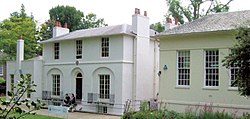This article includes a list of general references, but it lacks sufficient corresponding inline citations. (November 2015) |
| Keats House | |
|---|---|
 Keats House, Keats Grove (formerly John Street), pictured prior to reopening in 2009 after restoration. Adjoining on the right is the Heath Branch Public Library | |
| Former names | Wentworth Place Wentworth Cottage Lawn Cottage Laurel Cottage Lawn Bank[n 1] |
| General information | |
| Architectural style | Regency |
| Location | 10 Keats Grove, Hampstead, London, NW3 2RR |
| Country | United Kingdom |
| Construction started | c. 1814–15 |
| Completed | c. 1815–16 |
| Cost | Restoration: c. £500,000 (£424,000 from Heritage Lottery Fund) |
| Designations | Grade I listed[1] |
Keats House is a writer's house museum[2] in what was once the home of the Romantic poet John Keats. It is in Keats Grove, Hampstead, toward the edge of inner north London.[n 2] Maps before about 1915[3] show the road with one of its earlier names, John Street; the road has also been known as Albion Grove. The building was originally a pair of semi-detached houses known as "Wentworth Place". John Keats lodged in one of them with his friend Charles Brown from December 1818 to May 1820, and then in the other half of the house with the Brawne family from August to September 1820. These were perhaps Keats's most productive years. According to Brown, "Ode to a Nightingale" was written under a plum tree in the garden.
While living in the house, Keats fell in love with and became engaged to Fanny Brawne, who lived with her family in the adjacent house. Keats became increasingly ill with tuberculosis and was advised to move to a warmer climate. He left London in 1820 and died, unmarried, in Italy the following year.
The house is a Grade I listed building.[1]
Cite error: There are <ref group=n> tags on this page, but the references will not show without a {{reflist|group=n}} template (see the help page).
- ^ a b Historic England. "Keats House (Grade I) (1379221)". National Heritage List for England. Retrieved 27 January 2015.
- ^ "Official City of London Keats House website". Archived from the original on 27 September 2011. Retrieved 1 November 2009.
- ^ London, Hampstead sheet 1915 (Map) (1915, 1:2500 ed.). Ordnance Survey.
